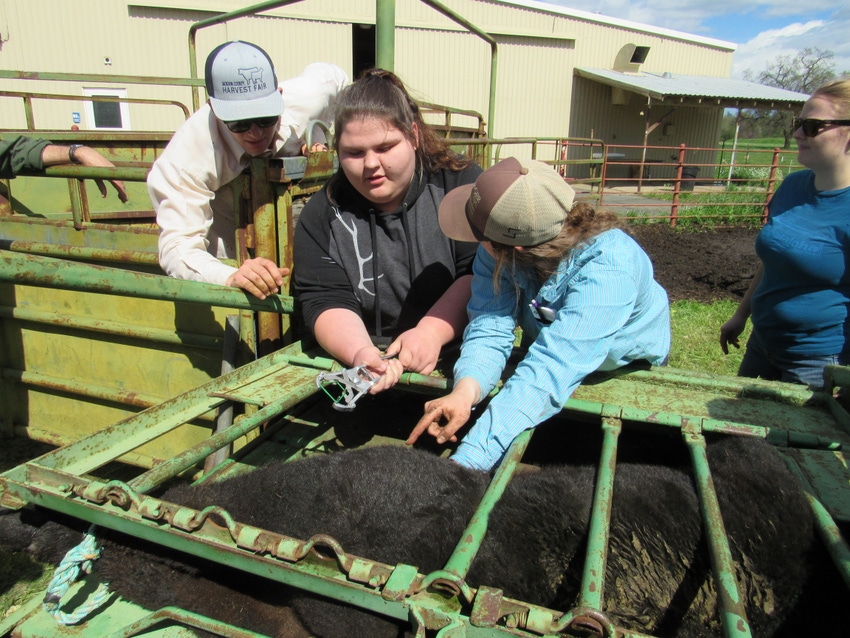
With a goal of eventually taking a lead role in her family’s cattle operation, Gracen Santinelli knew where she wanted to start her college studies.
“I was involved heavily in 4-H and FFA,” she says. “I chose this school because of the hands-on experience.”
Santinelli is student manager of the beef unit at Shasta College in Redding, Calif., whose farm-dormitory program immerses students in the day-to-day function of an agricultural operation.
She’s completing her second year in the program, and plans to stay for one more year and then transfer to Colorado State University. In the meantime, the Amador County, Calif., native takes home what she’s learning and teaches it to her family, she says.
“I think a lot of people get ahead of themselves” and go directly to a four-year university rather than starting at a community college, she says. “There’s no rush in life.”
Santinelli almost didn’t have the Shasta College farm to come to. A decade ago, instructors were feverishly scaring up community support to keep the program open amid a campus-wide budget crunch.
SAVING THE FARM
Alumni, area growers and county Farm Bureaus brought overflow crowds to meetings as trustees considered shuttering the program, which was then 60 years old.
Administrators instead tasked the farm with raising some of its own money, and the program initiated several fundraisers, including a fall harvest festival and country Christmas fair.
Trena Kimler-Richards, an instructor and program coordinator who advises a student leadership team, had just been hired part-time when the crisis hit in 2009. A former high school and California State University, Chico instructor, Kimler-Richards started calling everyone she knew to rally support for the program.
“When I first started, our average class size was 15,” Kimler-Richards says. “Now across the board it’s 24, and in my classes it’s 30 or 31.”
Today the Shasta College farm brings in revenue for its community college district, and the college agriculture and heavy equipment department keeps expanding its specialized offerings.
The college recently began offering associate degrees in animal science, agricultural business and plant science, and has opened up new options in range ecology, Kimler-Richards says.
ROAD TO SUCCESS
“They’ve increased our budget here because they understand the program is expensive,” she says, adding the college has made use of career-technical education grants such as California’s Strong Workforce Program and the federal Perkins Grant.
To begin the college’s long road to success, Kimler-Richards – who had rebuilt Red Bluff High School’s ag program in the 1980s – brought in rancher B.J. Macfarlane as farm manager in 2010.
A former beef herdsman at Chico State who works with his father raising Hereford cattle near Hat Creek, Calif., Macfarlane ran the farm for eight years until leaving in December to manage the Shasta District Fair. But he returns to the college farm occasionally to lead lessons, including a training one recent afternoon on vaccinating cattle.
“I have students who babysit for me,” Macfarlane says. “They’re good kids, which is the worst part of leaving the job. I enjoy being around the students.”
Macfarlane brings an industry perspective to his teaching. As its manager, he sought to run the college farm like a business, producing and selling premium-quality goats, pigs and cattle. The farm also grows alfalfa and winter wheat as well as providing irrigated pasture for its livestock.
“We’re not huge producers,” Kimler-Richards says. “It gives students in our classes an opportunity to work with livestock, and not just to raise calves to take to an auction. They’re involved in marketing.”
ANNUAL OPEN HOUSE
The farm hosts an open house every year for goat sales, she says.
“It gives them an opportunity to work with everything from selecting genetics to marketing and promoting livestock for sale,” she says.
The department’s heavy equipment program is also expanding, as next school year it plans to introduce a certification specifically for logging skills. Amid a nationwide shortage of truck drivers, the college’s truck driving class has doubled in size.
Most of Shasta’s agriculture students end up transferring to universities, with many of them going to Chico State, which also has a revenue-generating farm. Chico’s agriculture department recognized Shasta College faculty during a social gathering at this year’s Red Bluff Bull and Gelding Sale.
“Shasta College over the past eight or 10 years has become one of our top feeder schools,” says Sarah DeForest, the university’s director of external relations. “Their college of agriculture is doing a fantastic job preparing students who are ready to go to work. They’re very successful in our program.”
Shasta’s success story comes as college and university agriculture programs across the country have had to get creative to bring in money as state funding has gone down, says John Unruh, the dean of Chico State’s College of Agriculture.
“A higher percentage of funding has to come either from tuition or other sources,” he says. “That’s been a trend that’s been going on for quite a while.”
PROFITS AND EDUCATION
As at Shasta College, Chico State’s farm tries to maximize profits by selling commodities while also optimizing the students’ education, he says.
“We recognize that agriculture is a higher-cost field as we have a great emphasis on smaller class sizes and experiential learning opportunities,” Unruh says. “We have to support university farms to be that lab for students. We are a more lab-intensive program.
“You have to recognize that if we were a commercial operation, we would be doing things a lot differently at the farm than what we do because our priority is student education,” Unruh says. “That increases costs. There are more costs involved with students being out on the farm.”
At Shasta College and around the country, students are grateful for the hands-on opportunity. Yuba City native Haley Duenas is completing her first year at Shasta and eventually plans to attend Chico State.
“It really does a great job of helping teach students how to run and manage a farm,” says Duenas, who hopes to become a large-animal veterinarian. “It really instills that responsibility.”
‘WONDERFUL PROGRAM’
Sara Miller, who’s finishing her second year in Shasta’s dormitory program, got her start in FFA. The Sacramento native helps put on a competition during the FFA field day the college hosts in October.
“More than anything, you can make scenarios up with animals,” Miller says. “If you’re here all the time, you see things with animals you wouldn’t otherwise.
“It’s a wonderful program,” she says. “I’m glad they saved it 10 years ago.”
About the Author(s)
You May Also Like






